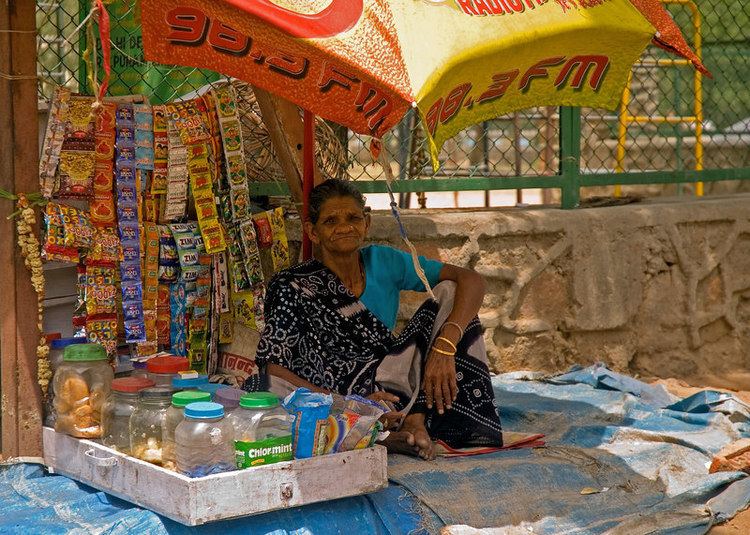 | ||
Gutka or Guṭkha is a preparation of crushed areca nut, tobacco, catechu, paraffin wax, slaked lime and sweet or savory flavorings. It is manufactured in India and exported to a few other countries. A mild stimulant, it is sold across India in small, individual-sized packets that cost between 2 and 10 rupees per packet. Gutka is consumed by placing a pinch of it between the gum and cheek and gently sucking and chewing. It is considered responsible for oral cancer and other severe negative health effects. As with paan and other smokeless tobacco products, there are preventive efforts to encourage users to quit and young people not to start.
Contents
Characteristics
Gutka is a powdery, granular, light brownish to white substance. Within moments of chewing mixing with saliva, the gutkha begins to dissolve and turn deep red in color. It may impart upon its user a "buzz" somewhat more intense than that of tobacco chewing, snuffing and smoking.
Effects
Highly addictive and a known carcinogen, gutkha is the subject of much controversy in India. Many states have sought to curb its immense popularity by taxing sales of gutkha heavily or by banning it outright.
Excessive gutkha use can eventually lead to loss of appetite, promote unusual sleep patterns, and loss of concentration along with other tobacco-related problems. A gutkha user can easily be identified by prominently stained teeth ranging from dirty yellowish-orange to reddish-black. The stains are difficult to remove by normal brushing and usually need the attention of a dentist. After gutkha is consumed, it is generally spat onto a wall or at the ground, causing an unsightly red stain that is quite resistant to the elements. Some building owners have taken to combating this unpleasantness by painting murals of Gods on their walls, with the idea that gutkha chewers would not spit on a God.
Gutka, a combination of arecanut, slaked lime, paraffin and katechu along with tobacco, is virtually poison. Promoted as a mouth freshener, this mixture is a combination of 4,000 chemicals of which at least 40 are carcinogenic compounds, say doctors.
People get addicted to it as gutka is reported to have stimulant and relaxation effects. While most consumers believe that the blend is not harmful, doctors, especially oncologists, say consumption of gutka is more harmful than any other form of tobacco.
This is because when a person chews gutka, the mixture directly enters the system through the oral cavity. In the case of smoking, 20% of the harmful chemicals reach the lungs and 80%is exhaled.
While narrowing of the blood vessels can cause gangrene, stoppage of blood supply in extreme cases can cause stroke. In women, consumption of gutka during pregnancy can result in low birth weight babies, he says.
“Overall, people can develop cancers of mouth, throat, lung and oesophagus; heart disease and related ailments. While most youngsters get easily addicted to it, women are in the habit of chewing tobacco or even inhaling snuff, which is even more harmful,”
Usage
Gutkha use can begin at a very young age. Due to its often flavorful taste, easy availability and low price, it is popular with poor children, who can exhibit precancerous lesions at a very early age as a result. Symptoms of cancer often appear by high school or college age. Social custom does not permit children in India to smoke cigarettes, so gutkha use, being all but invisible to others, is the method of choice. Gutkha is also used by many as an alternative to cigarettes and is claimed to curb the need to smoke, but eventually becomes another habit tough to quit. Gutkha also causes swallowing problems during night time sleeping leading to dry throat and restless sleep. This may eventually lead to throat cancer in users.. In 2008, about 5 million children under 15 were addicted to gutkha. A survey in Uttar Pradesh and Madhya Pradesh found precursors of mouth cancers in 16% of the children. According to the 2009-2010 survey by Global Adult Tobacco Survey, 53.5% of Indians use tobacco products (66.2% of men and 40% of women). Tobacco and gutka chewing makes up the majority of those figures with 48.07% of Indians using them, while bidi and cigarette smokers make up 8.4% and 5.9% of the population respectively.
India
Many states of India have banned the sale, manufacture, distribution and storage of gutka and all its variants. As of May 2013, gutka is banned in 24 states and 3 union territories. The federal Food Safety and Regulation (Prohibition) Act 2011 allows harmful products such as gutka to be banned for a year. This can be renewed annually, resulting in a permanent ban. The ban is enforced by the state public health ministry, the state Food and Drug Administration, and the local police. Enforcement of the law is generally lax and many shops still sell gutka, although it may not be displayed. Enforcemnent is stricter in some regions like Mumbai and Delhi, but illegal sale of gutka still occurs.
Offenders can be fined or receive prison sentences. The law has provisions of imposing fines up to ₹ 25000 on selling of products that are injurious to health.
Research firm Edelweiss estimates the gutka ban will cause the industry ₹ 15-20 billion in losses.
Advertising
Like alcohol and tobacco products, there is a ban on advertisement of gutka. Often tobacco companies advertise gutka as pan masala in order to skirt the ban on advertising tobacco products. Surrogate advertisements often use pan masala ads to promote gutka products with similar name and packaging.
According to the Food Safety and Standards (Prohibition and Restriction on Sales) Regulations, 2011 of the Food Safety and Standards Authority of India, misleading advertisement of such products invites a fine of ₹ 1,000,000.
